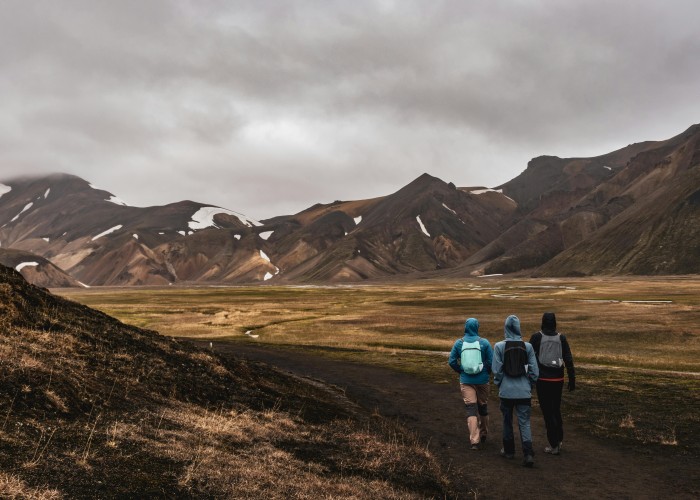If you’re planning an unforgettable hiking adventure, the Laugavegur Trail in Iceland belongs on your list. This trail winds through epic landscapes—from steaming hot springs and glacial rivers to black sand deserts and colorful rhyolite hills. Here’s a simple and helpful guide tailored for readers from the USA, UK, Australia, and Germany. No fluff—just clear, neutral, and practical advice. Laugavegur Trail Trek .
Overview
The Laugavegur Trail stretches roughly 55 kilometers, linking Landmannalaugar in the north to Thórsmörk in the south. It’s famous for its dramatic scenery and geographic diversity. You’ll cross volcanic deserts, mossy lava fields, geothermal areas, and green valleys carved by glaciers. This trek blends geological wonder with raw wilderness, making it a bucket-list destination for hikers worldwide.
Best Time to Visit
Timing matters here:
- Late June to early September is the most reliable period. Trails are generally clear of snow, and basic facilities are open.
- July and August offer the best balance of light and weather; expect mild temperatures and long daylight.
- Late June may still bring snow on higher paths—be prepared.
- Early September brings fewer people and dramatic autumn colors, but weather becomes more unpredictable.
Outside this window, the trek becomes more challenging and best left to experienced hikers.
How to Reach
Getting to the trailheads involves a few steps:
- Air: Fly into Reykjavik.
- Road: Landmannalaugar is accessible via 4×4 buses or rental vehicles suited to rugged terrain.
- Buses: Regular summer transfers connect Reykjavik with both Landmannalaugar and Thórsmörk.
- Plan ahead—transport schedules vary by season, and off-season options are limited.
Entry Fees and Permits
- No formal permits are needed for the Laugavegur Trail.
- There may be parking fees or small contributions for overnight huts or camping facilities.
- These fees are often low and subject to change. Cash or local card options are typically accepted at facilities.
Food Availability and Meal Options
Here’s what to expect on the trail:
- Mountain huts serve basic meals like soups, pasta, and coffee—but availability can vary.
- Self-catering is an option: bring lightweight meals or freeze-dried food to stay flexible.
- Snacks and energy bars are handy between stops. Be prepared for limited food options once on the trail. Laugavegur Trail Trek .
Packing List and Essentials
Here’s a practical list to keep you prepared and light:
- Waterproof jacket and pants.
- Warm layers (fleece and base layer).
- Good hiking boots and wool socks.
- Trekking poles for uneven terrain.
- Water bottle or hydration bladder.
- High-energy snacks and meals.
- Map, compass, or GPS device.
- Headlamp and spare batteries.
- Basic first aid kit.
- Sunglasses and sunscreen.
- Lightweight backpack rain cover.
Pack thoughtfully, as weather can shift fast, and trail services are minimal.
Safety Tips and Local Regulations
Safety first when trekking Icelandic wilderness:
- Check weather forecasts daily—storms move in quickly.
- Stick to marked paths to protect fragile moss and volcanic soil.
- Inform someone of your schedule and planned route.
- River crossings can be risky—use caution and daylight.
- Camping only in designated areas and practice Leave No Trace.
- Hot springs at trail’s end require caution: avoid scalding water and dangerous edges.
Tips for Beginners or First-Time Visitors
- Build your fitness with day hikes before tackling Laugavegur.
- Break the trek into stages—most do it in 4 to 6 days.
- Book hut stays early in summer. In busier months, facilities fill quickly.
- Be flexible: Iceland’s weather often changes plans on short notice.
- Consider hiking with someone who’s done the trail before or join a small group.
Local Customs and Cultural Etiquette
Respect for nature is part of Icelandic culture:
- Greet other hikers with a nod or quick hello.
- Keep noise low, especially near huts and stream valleys.
- Carry out all trash—even biodegradable waste.
- If foraging (berries or herbs), stick to what grows in common areas—avoid private land.
These simple habits show respect for the environment and local sentiment. Laugavegur Trail Trek .
Frequently Asked Questions (FAQs)
Q: How long does the Laugavegur Trail take?
A: Most hikers complete it in 4 to 6 days, depending on pace and weather.
Q: What is the walk difficulty?
A: Moderate to demanding—expect varied terrain, from volcanic plateaus to river crossings.
Q: What is the maximum altitude?
A: Highest elevation is around 1,100 meters, with changes that feel dramatic across landscape.
Q: Are there toilets on the route?
A: Yes, huts and camping areas typically provide basic toilet facilities. Always carry tissue.
Q: Do I need a map or GPS?
A: Yes. While trails are marked, fog or snow can make visibility poor. A GPS or map helps.
Q: Can I drink stream water?
A: Yes, but treat or filter it first—safe purification methods are a good idea.
Q: Are tents allowed anywhere?
A: You must camp in designated zones. Random camping is discouraged to protect moss and wildlife.
Final Thoughts
The Laugavegur Trail is one of the world’s standout treks—raw, beautiful, and unforgettable. With smart preparation and respect for the ever-changing conditions, this trail offers a journey of solitude, colors, and nature that stays with you long after. May every step be safe, and the view ahead always clear. Laugavegur Trail Trek .






Leave a Reply